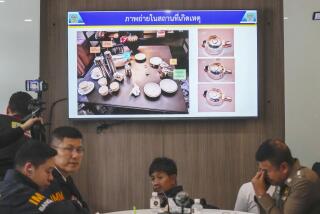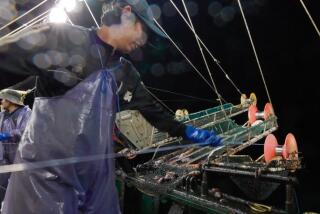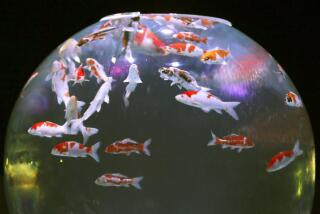CONSUMERS : Tropical Fish and Cyanide: Tips for the Wary Buyer
If you’re thinking about setting up a home aquarium with gorgeously colored tropical fish, it won’t do much good to be overly concerned about recent reports that fish imported from waters around the Philippines are caught by putting cyanide in the water.
There are a certain number of things to look for in selecting a healthy fish, experts say, but no sure way to tell whether it was caught with cyanide in the water--unless you were there.
That process, common in the Philippines for 20 years, involves pumping industrial sodium cyanide around offshore coral reefs, which forces fish to the surface where they can be more easily collected. It generally doesn’t kill the fish, but is believed to weaken them--and shorten their life-span.
With marine tropicals ranging in price from about $3 to $500 each--and a few rare ones going for as much as $1,000--hobbyists are increasingly interested in the health of the fish they buy.
The problem is, “you cannot tell visually if a fish has been caught with cyanide and anyone who claims he can is a fraud,” according to George Blasiola, a New Jersey pathobiologist and ichthyologist who specializes in the health of fish.
Tips that wholesalers and dealers offer for the consumer who wants to buy tropical marine or freshwater fish include buying from a reputable, established store; asking questions of the owner or salesperson about where the fish came from and if they were handpicked at the wholesaler’s; asking how long a particular fish has been in the store; and checking its behavior--if its eyes are clear and alert-looking, if its color is normal but not extreme, if it swims in a normal manner, if it’s eating.
“I think people should look at the fish one day and come back the next,” said Kevin Conway, who has owned Tropical Imports Unlimited in Glendale for 17 years. “And they should ask the salesperson to feed the fish. If it wouldn’t eat that day, but would the next day, I would buy him.”
Quarantines for Fish
Some dealers, experts say, go an extra step and quarantine new tropical fish for a week before putting them in with existing stock, but most simply don’t have the space for longtime quarantines.
“We don’t commonly quarantine,” Conway said. “But we will specifically quarantine. If a fish is not eating, I won’t sell him.”
A weak or sick fish, experts explain, will often swim in an odd manner with its tail drooping and its fins clamped to its body. It may swim erratically, flipping around in the tank or hovering near a corner.
“I handpick every fish we have,” said Jim Wolf, manager of the 40-year-old Aquarium Stock Company fish store in Los Angeles. “If I don’t like the way a fish looks--when you’re looking at him, he should turn around and look at you, too--I will talk the customer out of buying it and ask him to wait a few days.”
Wolf said that he tries to know exactly where the fish he buys are coming from, and would rather pay a little more money for ones he is sure haven’t been harvested with cyanide.
Possibly the best way to avoid getting a fish weakened by cyanide is to buy it from a dealer who can assure you that his or her stock comes from areas where the fish are hand caught and cyanide or other chemicals are not used. According to area importers, generally safe harvest areas include Hawaii, Fiji, New Caledonia, Tonga, Samoa, Florida, the Caribbean and the Red Sea.
“I’ve been going to the Philippines for 20 years and it (cyanide collecting) is something that everyone knows exists under the table,” said Phil Shane, who runs Quality Marine wholesalers near Los Angeles International Airport. “Cyanide is used on certain species, ones that are difficult to catch, small angelfish, for instance. But we can’t tell.
“We buy from the exporters,” Shane explained. “What happens is that a fisherman catches the fish. He gives them to a broker, who sells them to the exporter. The exporter wouldn’t be able to guarantee one way or the other (if the fish were caught using cyanide), and neither would we.”
Shane, who has been in the tropical fish wholesaling business for 22 years, said that he now has a place in Fiji from which he imports tropical fish.
“It’s cheaper in the Philippines,” he said, “But the onus really falls back on the hobbyists. Are they willing to pay more or do they just want something cheap rather than recognize what a good fish is. I pay $3.50 for a fish from Fiji versus 90 cents for the same fish from the Philippines.”
Shane and other wholesales queried admit that tropical fish are a big business, and some people are more interested in making money than importing quality fish. Every week in Los Angeles, according to Shane, “in excess of $100,000-worth of marine fish” are purchased.
No Licensing for Stores
Another problem, Shane added, is that there is no licensing for fish stores and purveyors are not always knowledgeable. Often, he said, “they’re aspiring hobbyists who have gotten carried away and opened a store. There are reputable ones but there also are a lot of wildflowers, we call them. They come up very fast, last a short time and disappear.”
Federal and state officials apparently don’t have much say in the matter of tropical fish either.
The U.S. Dept. of Fish and Wildlife regulates importing and exporting of fish on endangered species lists; the California Fish and Game department oversees state laws prohibiting importing of certain species that are dangerous and could take over a fish population, like piranha.
But “we don’t have much jurisdiction over what’s going on in the rest of the world,” said Sheila Einsweiler, a U.S. Fish and Wildlife inspector in Los Angeles, the port of entry for the bulk of fish shipped from the Far East and South Pacific. “We suspect everyone within the business knows about the cyaniding in the Philippines, but I don’t know that anyone has been asking us to do anything about it. . . . Some importers here are very aware of it and do not go through the Philippines for their fish.”
Einsweiler said that she didn’t know how much “the general public is being threatened” by the cyanide scare because the majority of the fish who die, die en route to the U.S. “A lot more die before they even get to the public,” she explained.
But some tropical fish experts feel that the cyanide issue has been overblown recently and cite attempts already made by the U.S. tropical fish industry to regulate cyanide use.
Blasiola, a former fisheries biologist at the California Academy of Sciences in San Francisco, led a 1987 fish industry fact-finding mission to the Philippines to study the cyanide problem.
After four trips, Blasiola said, the observers issued a 50-page report on the matter this year, and signed an agreement with the Philippine Department of Agriculture and the International Marine Alliance of the Philippines to train Philippine tropical fish collectors to catch the fish by hand rather than using chemicals.
“Cyanide is a poison, no question about that,” Blasiola said. “It (damage) depends on the amount the fish get, if they are removed immediately from the water into fresh saltwater, and whether or not they are packed and shipped properly. . . . But the cyanide damage can put the fish on the edge and then stress (can put the fish) over it.”
“Before they used cyanide, they used dynamite,” added Walt Smith, a fish wholesaler from San Pedro. Smith works as a middleman who handpicks tropical fish from local wholesalers and then sells to retail stores out of state. He charges about 15% more than regular wholesalers, and offers “hand caught, undrugged” marine fish from Tonga and Samoa.
“It would be nice if cyanide did not exist in the industry. But it also would be better if they weren’t over-packed and were shipped properly for less stress. I think if you’re going to take a fish out of a natural habitat, you should try to make sure as much as you can that it has a fair chance to live.”
More to Read
Inside the business of entertainment
The Wide Shot brings you news, analysis and insights on everything from streaming wars to production — and what it all means for the future.
You may occasionally receive promotional content from the Los Angeles Times.










